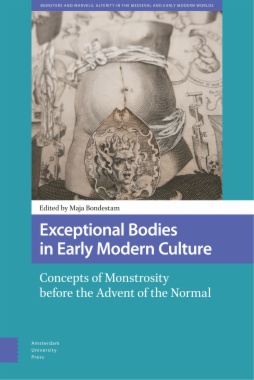Drawing on a rich array of textual and visual primary sources, including medicine, satires, play scripts, dictionaries, natural philosophy, and texts on collecting wonders, this book provides a fresh perspective on monstrosity in early modern European culture. The essays explore how exceptional bodies challenged social, religious, sexual and natural structures and hierarchies in the sixteenth, seventeenth and early eighteenth centuries and contributed to its knowledge, moral and emotional repertoire. Prodigious births, maternal imagination, hermaphrodites, collections of extraordinary things, powerful women, disabilities, controversial exercise, shapeshifting phenomena and hybrids are examined in a period before all varieties and differences became normalized to a homogenous standard. The historicizing of exceptional bodies is central in the volume since it expands our understanding of early modern culture and deepens our knowledge of its specific ways of conceptualizing singularities, rare examples, paradoxes, rules and conventions in nature and society.
- Cover
- Table of Contents
- Introduction
- 1. The Moresca Dance in Counter-Reformation Rome: Court Medicine and the Moderation of Exceptional Bodies
- 2. Monsters and the Maternal Imagination: The ‘First Vision’ from Johann Remmelin’s 1619 Catoptrum microcosmicum Triptych
- 3. The Optics of Bodily Deviance: Juan Ruiz de Alarcón’s Path to Public Office
- 4. ‘The Most Deformed Woman in France’: Marguerite de Valois’s Monstrous Sexuality in the Divorce satyrique
- 5. Curious, Useful and Important: Bayle’s ‘Hermaphrodites’ as Figures of Theological Inquiry
- 6. An Education: Johannes Schefferus and the Prodigious Son of a Fisherman
- 7. Ambiguous and Transitional Bodies: Stillbirth in Stockholm, 1691-1724
- Afterword
- Index
- List of Illustrations
- Figure 1.1. Pirro Ligorio, Pyrrhichia saltatio [The Pyrrhic dance], 1573. Engraving from Girolamo Mercuriale, De arte gymnastica Libri sex, in quibus exercitationum omnium vetustarum genera, loca, modi, facultates & quidquid deniq. Ad corporis humani exer
- Figure 2.1. Detail of the monstrous creature in Johann Remmelin, ‘First Vision’, 1619. Etching and engraving from Catoptrum microcosmicum. Wellcome Library, London. Photograph: Rosemary Moore.
- Figure 2.2. Johann Remmelin, ‘First Vision’, 1619. Etching and engraving from Catoptrum microcosmicum. Wellcome Library, London. Photograph: Rosemary Moore.
- Figure 2.3. Johann Remmelin, ‘Second Vision’, 1619. Etching and engraving from Catoptrum microcosmicum. Wellcome Library, London. Photograph: Wellcome Library.
- Figure 2.4. Johann Remmelin, ‘Third Vision’, 1619. Etching and engraving from Catoptrum microcosmicum. Wellcome Library, London. Photograph: Rosemary Moore.
- Figure 2.5. Jacob Frölich, after Heinrich Vogtherr, Anatomy, or, a Faithful Reproduction of the Body of a Female, 1544. Woodcut. 55 x 25 cm. Wellcome Library, London. Photograph: Wellcome Library.
- Figure 2.6. Detail of the Tetragrammaton in Johann Remmelin, ‘First Vision’, 1619. Etching and engraving from Catoptrum microcosmicum. Wellcome Library, London. Photograph: Rosemary Moore.
- Figure 2.7. Detail of the devil in Johann Remmelin, ‘First Vision’, 1619. Etching and engraving from Catoptrum microcosmicum. Wellcome Library, London. Photograph: Rosemary Moore.
- Figure 2.8. Detail of the fetus in Johann Remmelin, ‘First Vision’, 1619. Etching and engraving from Catoptrum microcosmicum. Wellcome Library, London. Photograph: Rosemary Moore.
- Figure 2.9. Charles Estienne, Female anatomical model showing the location of the caesarean cut, 1545. Woodcut from p. 260 of Charles Estienne, De dissectione partium corporis humani [On the dissection of the parts of the human body] (Parisiis: Apud Simon
- Figure 2.10. Detail of the main anatomical figures with the flaps raised. From Johann Remmelin, ‘First Vision’, 1619. Etching and engraving from Catoptrum microcosmicum. Wellcome Library, London. Photograph: Rosemary Moore.
- Figure 6.1. Johannes Schefferus, A boy with a so-called prodigious appearance. Drawing from Chapter IV of Johannes Schefferus, ‘Variae historiae’, 1670-1679, Uppsala University Library, MS X 292. Photograph: Uppsala University Library.
- Figure 6.2. Johannes Schefferus, The monster from Lillebered. Drawing from Chapter VIII of Johannes Schefferus, ‘Variae historiae’, 1670-1679, Uppsala University Library, MS X 292. Photograph: Uppsala University Library.
- Figure 6.3. Johannes Schefferus, A large stone, found inside the bladder of a man. Drawing from Chapter III of Johannes Schefferus, ‘Variae historiae’, 1670-1679, Uppsala University Library, MS X 292. Photograph: Uppsala University Library.
- Figure 6.4. Frontispiece, Julius Obsequens and Conrad Lycosthenes, Julii Obsequentis de prodigiis liber: cum annotationibus Joannis Schefferi […] accedunt Conr. Lycosthenis supplementum Obsequentis; item librorum à Scheffero editorum index (Stockholm, 167
- Figure 7.1. Death and the infant: The child has a dull expression in its chubby face. Death squeezes it hard to her emaciated breast. She turns her back at us and increases her speed. Physician Lars Roberg, who inserted her portrait in Lijkrevningstavlor
- Figure 7.2. Podalic version demands great mental and physical strength of the performer. He or she who wants to try it must “not stand sleeping, and have the vigor, and the heart, to carry it through”.27 Johan von Hoorn, Den Swenska Wäl-öfwade Jord-Gumman

